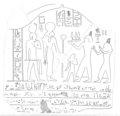Top Qs
Timeline
Chat
Perspective
Twenty-second Dynasty of Egypt
Ancient Egyptian dynasty From Wikipedia, the free encyclopedia
Remove ads
The Twenty-second Dynasty was an Ancient Egyptian dynasty of ancient Libyan origin founded by Shoshenq I.[1] It is also known as the Bubastite Dynasty, since the pharaohs originally ruled from the city of Bubastis.[2]
This article needs additional citations for verification. (February 2023) |
The Twenty-first, Twenty-second, Twenty-third, Twenty-fourth, and Twenty-fifth dynasties of ancient Egypt are often combined under the group designation of the Third Intermediate Period.
Remove ads
Rulers
Summarize
Perspective
The pharaohs of the Twenty-second Dynasty were a series of Meshwesh (ancient Libyan[a] tribe) chieftains, who ruled from c. 943 BC until 716 BC. They had settled in Egypt since the Twentieth Dynasty and were known in Egypt as the 'Great Chiefs of the Ma' (Ma being a synonym of Meshwesh). Manetho states that this Egyptianized ancient Libyan dynasty first ruled over Bubastis, but its rulers almost certainly governed from Tanis, which was their capital and the city where their tombs have been excavated.
Another pharaoh who belongs to this group is Tutkheperre Shoshenq. His period of rule within this dynasty is currently uncertain, although he is now thought to have governed Egypt early in the 9th century BC for a short time between Osorkon I and Takelot I. The next ruler at Tanis after Shoshenq V was Osorkon IV. This pharaoh is sometimes not believed to be a member of the 22nd Dynasty since he only controlled a small portion of Lower Egypt together with Tefnakhte of Sais, whose authority was recognised at Memphis—and Iuput II of Leontopolis.
Pharaohs
The known rulers during the Twenty-second Dynasty include:
Celebration and folklore
The rise to power of the Twenty-second dynasty and its founder Sheshqonq, a Libyan Amazigh king of the Meshwesh tribe, is remembered as year 0 of the Berber calendar celebrated by the Berber New Year each year: the Yennayer. The character is known as Ouchachnaq, hero of a Kabyle tale, "Sheshqonq and Mira", but is also mentioned in an ancient Berber nursery rhyme from the region under the name of Ouchnaq.[6]

Twenty-third Dynasty
The so-called Twenty-third Dynasty was an offshoot of this dynasty perhaps based in Upper Egypt, though there is much debate concerning this issue. All of its kings reigned in Middle and Upper Egypt including the Western Desert Oases.
Remove ads
See also
Notes
References
Wikiwand - on
Seamless Wikipedia browsing. On steroids.
Remove ads












